CERAD - Centre for Environmental Radioactivity (SFF)
Below are detailed descriptions and outcomes in CERAD'S umbrella projects. For work package descriptions, please see CERAD's home page.
RA1 SOURCE - Umbrella projects
UMB1A: Particle Sources
Models for predicting the environmental impact of radioactive contamination are mostly based on the assumption that radionuclides are present as ions, whereas particles show marked differences in behaviour. This may result in significant errors in assessment and modelling of impact. UMB1A has addressed this.
- The research in umbrella 1A has focused on particle characteristics, transformation rates, remobilization and prediction of ecosystem transfer. We have studied particles containing U and/or Pu and originating from sources such as nuclear weapon tests (Semipalatinsk, Kazakhstan), safety tests (Maralinga, Taranaki, Australia), nuclear reactor accidents (Chernobyl, Fukushima) and NORM (Fen, Søve, Norway; Former Soviet Union uranium mining sites in central Asia). NMBU's unique archive of nano- and micrometer-sized radioactive particles from different sources was utilized.
- New state-of-the-art methods for particle characterization have been developed, involving advanced micro- and nano-analytical techniques. These have enabled the quantification of particle transformation as a consequence of exposure to leaching media. The results from leaching experiments show that particle weathering and leaching depend on the oxidation state of the carrying matrix and that retention in soils and sediments delay the ecosystem transfer. These results are important for improving the impact prediction models for radioactive contamination in the environment.
- We developed new state-of-the-art methods to detect and localize low-level radioactive particles within organisms. The results show that uptake of particles in snails and mussels occurs, and that particles retained in tissues then act as point sources. This retention phenomenon was demonstrated in samples from contaminated ecosystems as well as from laboratory experiments. When retention occurs, the use of concentration ratios (CR) in environmental impact modelling will give rise to large uncertainties.
- Thanks to Umb1A research, particle characteristics can now be linked to specific sources, to ecosystem transfers (RA2) and biological effects (RA3). The new insights in particle deposition and time-dependent remobilization of associated radionuclides have enabled us to improve the accuracy of impact and risk assessment models by replacing constants with time-functions.
Leader:
UMB1B: Dispersion Modelling: Atmospheric and Marine
The main objective is to improve atmospheric and marine dispersion models for predicting transport of radioactive releases (e.g., implement particle codes) and to enable identification of unknown sources contributing to radioactive releases.
Most atmospheric and water dispersion models suffer from rather large uncertainties due to poor parametrization of the source term input data, and the probability of transport from a given source is usually not accounted for within large-scale modeling. Improvements of marine modelling is focused on coupling Lagrangian transport models (e.g., LLM species, colloids and particles) to the ROMS ocean model.

Map with probability of arrival of radioactive cloud to a given location from a hypothetical accident in the Sellafield nuclear facilities (on the left) and deposition map for Cs-137 from the worst case scenario for hypothetical accident. Units: Bq m-2 (on the right). Photo: sigdah Leader
Read more about how we can follow radionuclides in the ocean here.
Erik Berge
MET
UMB1C: UV/Ionising Radiation and Dosimetry
The dosimetry of UV and ionizing radiation is central to CERAD’s research. The centre measures, characterizes and monitors doses in experiments at the NMBU gamma irradiation facility, as well as in the field, using passive dosimeters combined with GPS monitoring (i.e., wildlife dosimetry).
Under Umbrella 1C, we develop a common dose concept for ionizing and UV radiation, in order to utilize the existing UV – network and the UV –dose maps within areas affected by radioactive fallout or NORM.
In collaboration with international research partners, we have attached dosimeters with GPS to free-ranging wildlife (Reindeer in Norway, Brown Bear in Sweden, and Wild Boar and Snakes in Japan). The instruments collect dosimetry as well as location data of the animals in almost real-time frequencies, as the animals move naturally through habitats that vary widely in contaminant levels. We have thus obtained much more accurate measurements than have been possible before (external dose was derived from soil samples and a Concentration Ratio, with large uncertainties).
This research has shown us how animals use spatially complex micro-habitats over time, and how this results in dose variations. The added precision is most important in dose-effect research, which has traditionally been plagued by large uncertainties. Our research is providing much needed data on the effects of chronic exposures to low-dose rate exposures and some results of mammalian models, such as boar, can be extrapolated to humans.
Umbrella project leader:

Elisabeth Lindbo Hansen
DSA
RA2 SOURCE - Umbrella projects
UMB2: Dynamic transfer
Since 2013, RA2 has focused on improving models towards a more dynamic approach instead of assuming steady-state, and to link speciation, mobility, transfer and biological uptake to effects in environmental organisms (RA3).
The prevailing view is that further substantial progress can be made by parameterizing and validating (dynamic) models under controlled, experimental conditions and by comparative studies of areas with well described contamination. The key priorities for RA2 includes:
- Characterize the transfer of radionuclides under field conditions, identifying factors (physico-chemical, biological etc.) that influence the dynamics of transfer (e.g., observatory sites, field tracer studies). Thus, future studies within contaminated sites (observatory sites) such as Chernobyl and Fukushima, and NORM sites will be important to characterize transfer to both aquatic and terrestrial organism groups. Alongside field studies, controlled field experiments will be performed; 1) Controlled aquatic field experiment in contaminated lakes to study uptake and depuration rates of radionuclides in aquatic organisms, and 2) Controlled tracer field experiments to simulate deposition of I-131 and other RN/elements on agricultural land and study tracer redistribution between biological compartments.
- Investigate climate change impacts on transfer of radionuclides (characterize transfer at different temperatures) in different ecosystems and characterize transformation processes affecting radionuclides and stable analogues in aquatic mixing zones or estuaries where changes in speciation occurs, having major influence on biological uptake and effects.
- Quantify the effects of radionuclide speciation on dynamic uptake and biological half-life under controlled laboratory conditions (e.g., Kd, CR, TF/TC/Tag, BCR, tissue distribution and protein interaction). Thus, toxicokinetic studies in aquatic and terrestrial organisms will be prioritized to identify the impact of environmental parameters and competing ions along with studies of internal distribution in environmental organisms.
- Further development of models which describe the dynamics of transfer within different ecosystems and accounting for the findings (e.g., ERICA dynamic tool).
- Perform comparative investigations related to speciation, mobility and biological uptake as observed in Chernobyl and Fukushima
There are close connections between these priorities, and the model set up will be used in the experimental design: identifying what are the important parameters required by the model and how might these be derived through experimentation. The models can be used to make predictions and these can be tested through lab experiments and field observation. These considerations still hold true for the next 5 years.
RA3 EFFECT - Umbrella projects
UMB3A: Mechanisms determining species radiosensitivity
About UMB3A
Under UMB3A, we are studying the effect of chronic low to medium dose rate gamma radiation on organisms, with the help of NMBU’s Co-60 irradiation facility.
Our main hypothesis has been that an organism’s capacity to mitigate oxidative stress -and thus maintain essential enzyme functions- determines its ability to repair the damage inflicted on essential macromolecules such as DNA. Indirect effects of radiation, particularly the formation of free radicals, can in turn damage cell components and cause disruption of signalling systems and metabolism.
The research has focused on three main topics:
- Interspecies radiosensitvity comparison
- Life stage-dependent radiosensitivity
- Vulnerable cell types and cellular processes

Figure 1. The Biological Effects Toolbox for interspecies comparison of radiosensitivity.
Photo: DA BredeLeader
Species radiosensitivity
We have constructed a standardized framework (SOP) for exposure, dosimetry and effects assessment. A total of 12 different model species have been studied using a standard set of comparable dose rates, and biological endpoints to determine their sensitivity to gamma radiation (Fig. 1). For each species, the toxicity has been characterized using the adverse outcome pathways (AOP) framework.
An important output from this has been to implement structured mechanistic insights of molecular toxicogenomics and quantitative toxic effects data into AOPs. For Daphnia magna, Song and co-authors (ref 4) developed an AOP for radiation-induced cellular Reactive Oxygen Species (ROS) as a molecular initiating event (MIE), connected to key events (KEs), such as increased oocyte apoptosis that leads to reduced fecundity as the adverse outcome (AO), which reduced reproduction at the population level (Fig. 2).
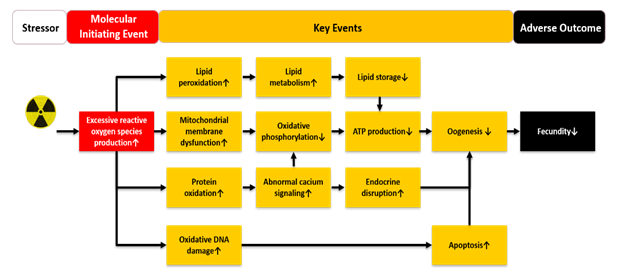
Figure 2. AOP network on radiation-induced excessive ROS leading to reduced reproduction. Photo: You Song This approach has generated a unique data set that enabled us to quantify differences in radiosensitivity between five different plant species ranging from radiation-tolerant algae and Arabidopsis to the more sensitive duckweed and pine trees (ref 1, 5, 7). All plant species showed similar DNA damage levels, but different effects with respect to development, growth and survival. This demonstrates that plants have very different capacities to tolerate and mitigate radiation-induced damage. We are currently investigating the mechanisms conferring the differences in tolerance between Arabidopsis and Norway spruce.
<strong>Life stage-dependent radiosensitivity and vulnerable cell types and cellular processe</strong>s
Another important objective has been to determine which life stages are more sensitive to the harmful effects of ionizing radiation. We have conducted targeted irradiation of embryogenesis, juvenile and adult stages including gonadal development, in invertebrate, fish and a mammal model species.
Embryogenesis is a delicate process that involves a multitude of epigenetic and transcriptional programs required for cell differentiation, tissue establishment and organogenesis. We employed zebrafish to target the effects of radiation on the early embryogenesis and compared it with effects onto adult fish. The results showed a clear effect of low doses >1.5 mGy of gamma radiation on gene expression in embryos during the early gastrula stage, while prolonged exposure of 48 and 96 h showed a low but significant increase of adverse phenotypic effects at total dose > 4 mGy (ref 6).
A further hypothesis we have tested is that stem cell functions are susceptible to damage by radiation, and that ‘late effects’ such as developmental malformations, or reproductive defects, originate from damage to stem cell populations. We specifically targeted the gonadal development in young adult zebrafish and monitored the effects on reproduction and the resulting offspring. The adult fish tolerated a high total dose, but the radiation had a severe effect on the number and viability of their offspring. The heritable and epigenetic effects mechanisms were further studied as part of Umbrella 3C.
In the nematode C. elegans we have investigated the contribution of radiation-induced cellular ROS in vivo, and the interplay between defence mechanisms and cellular adverse effects (ref 2, 3). While somatic cells, including embryos, show a remarkable tolerance, reproduction is highly vulnerable to radiation (ref 3). We have shown that the reprotoxic effect of radiation is life stage-dependent, and that irradiation during the early larval stage caused the most damage. This stage is crucial to gonadal development, and we have identified spermatogenesis as the most radiosensitive process (ref 3).
Molecular evidence indicates that radiation-induced DNA-damage during sperm meiosis leads to faulty spindle formation, chromosomal condensation and chromosomal segregation, which leads to a reduced number of spermatids (Fig. 3). The reduced number of spermatids accounts for >90% of the negative effect on reproduction. It is very interesting that radiation did not influence the function of the gonadal stem cells, even though the sperm formation was impaired and germ cell apoptosis was elevated. This is a clear demonstration that not all types of stem cells are vulnerable to radiation.

Figure 3. Proposed model for gamma radiation induced defective sperm meiosis in the C. elegans hermaphrodite. Repair of complex DNA damage such as DSB is initiated via histone demethylation by spr-5, which concomitantly represses set-17 regulated genes including msp. DNA damage onto the gametes causes defective spindle formation and chromosomal segregation. The concerted effect leads to reduced number of mature sperms with the downstream feedback inhibition of oocyte maturation and sheet cell contraction signalling. Photo: DA Brede Key publications
- Xie L, Solhaug KA, Song Y, Brede DA, Lind OC, Salbu B, Tollefsen KE (2019). Modes of action and adverse effects of gamma radiation in an aquatic macrophyte Lemna minor. Sci Total Environ. 680: 23-34.
- Maremonti E, Eide DM, Rossbach LM, Lind OC, Salbu B, Brede DA (2020). In vivo assessment of reactive oxygen species production and oxidative stress effects induced by chronic exposure to gamma radiation in Caenorhabditis elegans. Free Radic. Biol. Med. 152: 583-596.
- Maremonti E, Eide DM, Oughton DH, Salbu B, Grammes F, Kassaye YA, Guédon R, Lecomte-Pradines C, Brede DA (2019). Gamma radiation induces life stage-dependent reprotoxicity in Caenorhabditis elegans via impairment of spermatogenesis. Sci Total Environ. 695: 133835.
- Song Y, Xie L, Lee Y, Brede DA, Lyne F, Kassaye Y, Thaulow J, Caldwell G, Salbu B, Tollefsen KE. (2020). Integrative assessment of low-dose gamma radiation effects on Daphnia magna reproduction: Toxicity pathway assembly and AOP development. Sci Total Environ. 705: 135912.
- Blagojevic D, Lee Y, Brede DA, Lind OC, Yakovlev I, Solhaug KA, Fossdal CG, Salbu B, Olsen JE (2019). Comparative sensitivity to gamma radiation at the organismal, cell and DNA level in young plants of Norway spruce, Scots pine and Arabidopsis thaliana. Planta 250(5): 1567-1590.
- Hurem S, Martín LM, Brede DA, Skjerve E, Nourizadeh-Lillabadi R, Lind OC, Christensen T, Berg V, Teien HC, Salbu B, Oughton DH, Aleström P, Lyche JL (2017). Dose-dependent effects of gamma radiation on the early zebrafish development and gene expression. PLoS One 12(6): e0179259.
- Gomes T, Xie L, Brede D, Lind OC, Solhaug KA, Salbu B, Tollefsen KE (2017). Sensitivity of the green algae Chlamydomonas reinhardtii to gamma radiation: Photosynthetic performance and ROS formation. Aquat Toxicol. 183: 1-10.
UMB3B: Combined toxicity and cumulative risk
We have constructed a standardized framework (SOP) for exposure, dosimetry and effects assessment. A total of 12 different model species have been studied using a standard set of comparable dose rates, and biological endpoints to determine their sensitivity to gamma radiation (Fig. 1). For each species, the toxicity has been characterized using the adverse outcome pathways (AOP) framework.
An important output from this has been to implement structured mechanistic insights of molecular toxicogenomics and quantitative toxic effects data into AOPs. For Daphnia magna, Song and co-authors (ref 4) developed an AOP for radiation-induced cellular Reactive Oxygen Species (ROS) as a molecular initiating event (MIE), connected to key events (KEs), such as increased oocyte apoptosis that leads to reduced fecundity as the adverse outcome (AO), which reduced reproduction at the population level (Fig. 2).
Umbrella project leaders:

Knut Erik Tollefsen
NIVA

Terje Christensen
DSA
UMB3C: Transgenerational hereditary, reproductive and epigenetic effects
Under UMB3C, the focus has been on reproduction, genotoxic effects and the underpinning explanatory mechanisms. We are following the offspring of (mice and zebrafish) parents exposed to radiation, to test the hypothesis that exposure during the formation of gametes affects the offspring development and phenotype, and to link these effects to changes in gene expression. Previous results obtained for selenium deficient male mice exposed to gamma radiation demonstrated reproduction failure when low antioxidant status is combined with stressors.
Previous results obtained for AB wild type zebrafish exposed to gamma radiation demonstrated reprotoxic effects, lower embryo production and genomic instability in offspring after exposure to dose-rates ≥10 mGy/h during gametogenesis. These effects included damages to female reproductive organs, and genotoxic effects such as persistently increased micronuclei and DNA damage long time post-irradiation. In offspring of F1 of exposed parents, oxidative stress persisted in embryos long term after parental irradiation, including gene expression patterns pointing to disrupted reproductive and developmental pathways, global DNA methylation differences, histone modifications and persistent altered non-coding RNA expression. The parentally exposed embryos (not exposed themselves) showed developmental changes in the eyes with malformed eye membranes and lens suggesting that parental exposure induce developmental effects in the offspring.
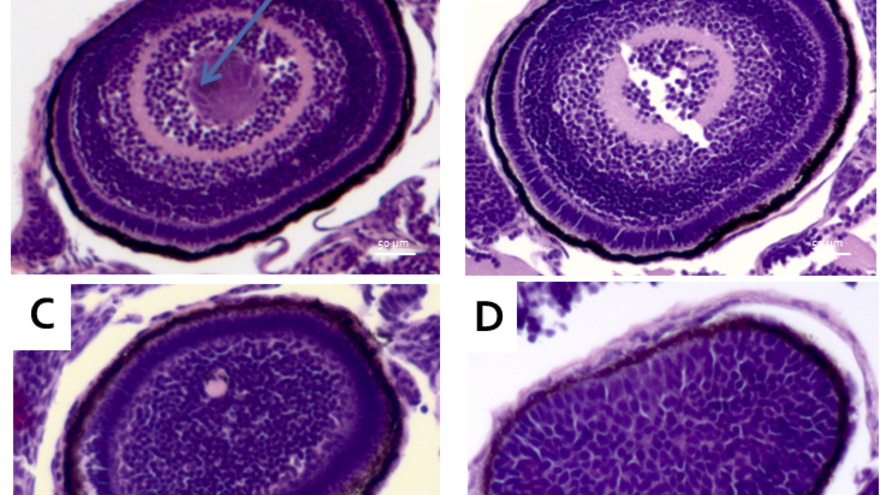
A. Control. Normal eye morphology )3 dpf=, with clear lensm, clearly defined layers of cells surrounded by the retinal layer
B. F1-10 E. Cells present in the lens
C. F1-10 G. Presence of cells in the lens and poor differentiation of the cells outside the lens.
D. F1-10GE. Cells in the lens, undifferentiated cellular layer of the eye.Photo: Selma HuremGamma radiation dose rate of 40 mGy/h during gametogenesis in zebrafish caused the complete disappearance of reproductive organs, while during embryogenesis the reproductive organs were replaced by fat tissue. Dose rate of 10 mGy/h during embryogenesis and up to 21 days caused a 90% reduction in the number of females in the population, including a lower embryo production.
A further hypothesis we have worked with is that primordial germ cells (PGC) are most susceptible to damage by radiation, and that ‘late effects’ such as developmental malformations, or reproductive defects, originate from damage to PGCs cell populations. The zebrafish model are used with the objective to study developmental effects of gamma radiation during sensitive life stages including gametogenesis, embryogenesis and the prepubertal using two lines of zebrafish : a transgenic (vas:egfp) with fluorescent label of germline-specific primordial germ cells (PGC) and an AB wild type (wt) strain.
To determine how germline development is affected in: (i) F0 embryos exposed between 2.5- 5.5 hpf and juvenile F0 fish exposed between 0-21 dpf; and (ii) F1- F3 offspring from exposed parental fish. The transgenic line allows imaging of migrating PGCs during germline development and isolation of the PGC population for single cell type analyses after FACS mediated cell sorting of homogenized embryos and larvae. Analyses of 5.5 hpf embryos and information on the early programming of the zygotic epigenome give insights into mechanisms behind later phenotypic observations.
Subgoal 1. The ATAC-seq analysis of embryos from FO exposed parents revealed a dose response effect with 346, 1774 and 8483 loci showing altered access in chromatin structure after 0.1, 1, and 10 mGy/h (Fig. 1). 1-2 % of fish developed distinct phenotypes with tumors and pigment disorganization, and GFP fluorescence was decreased in offspring embryos from both groups of exposed parental fish
Umbrella project leaders:

Peter Alestrøm
NMBU
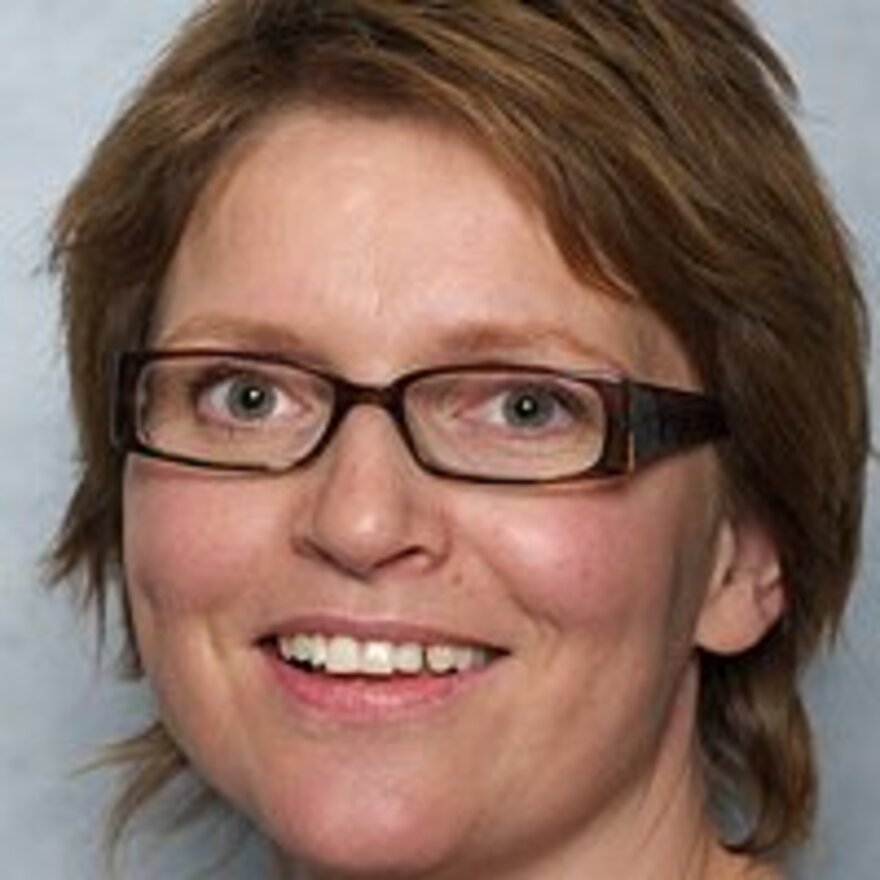
Ann Karin Ohlsen
FHI
RA4 RISK - Umbrella projects
Aim
It is CERAD’s overall goal to reduce the inherent uncertainty in predictive modelling and risk assessment of radiation. Our research results will thus have direct implications for decision making and management and communication of risks.
We have learned from the other Research Areas how sources and associated releases impact organisms and ecosystems, even at low doses, and adjusted model predictions accordingly. RA4 has then applied an ecosystem approach to finetune the risk assessment of radiation and to inform and guide radiation protection. We have included socioeconomic impacts in our considerations, given their increasingly recognised importance. RA4 has three umbrella projects.
UMB4A: Laboratory and field studies in an ecosystem approach
The main aim of this Umbrella is to evaluate the consequences of radiation at ecosystem level. Our current knowledge about effects of radiation is mainly based on laboratory or field studies of single species. Here, we cover ecosystems: multiple species and the abiotic environment.
Our hypothesis is that ecosystem interactions and processes (e.g. food chain interactions, competition between and within species, changes in biodiversity) can result in indirect effects from exposure to ionizing radiation.
Hypothesis
Our overarching hypothesis has been that ecosystem processes (e.g. food chain interactions, competition between and within species, changes in biodiversity) can result in indirect effects from exposure to ionizing radiation. Under UMB4a, we have used experimental micro- and mesocosms to explore such effects. Micro- and mesocosms in biological studies are artificially created ecosystems used to predict the behaviour of natural ecosystems.
For example, a microcosm can be a small aquatic system in an aquarium-like tank, or a terrestrial system in a greenhouse. Some larger mesocosms have been placed in netted-off areas in ponds, lakes or even oceans. Larger ecosystems have also been created to replicate an environment and study global scientific issues like climate change.
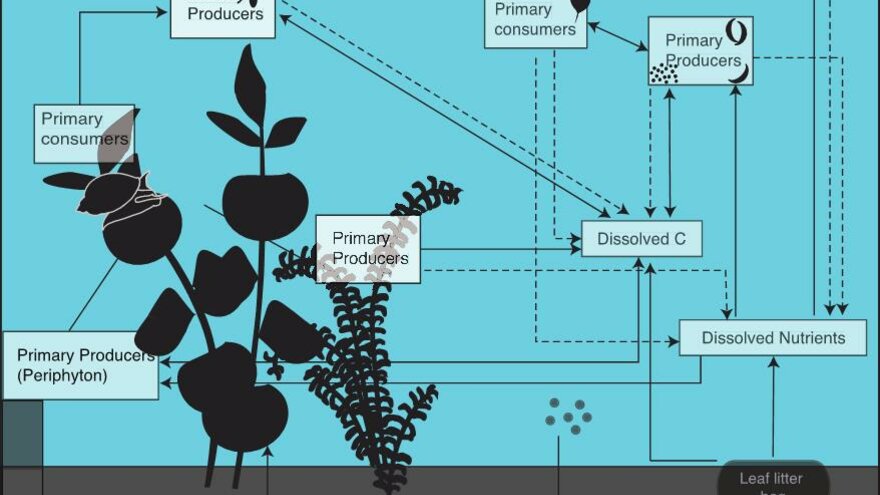
Figure: Conceptual model of the microcosm exposed to gamma, illustrating each species and component of the aquatic ecosystem and the interactions between them. Solid lines = trophic transfer and dotted line = excretion/decay. Photo: Tanya Hevrøy DSA Leader
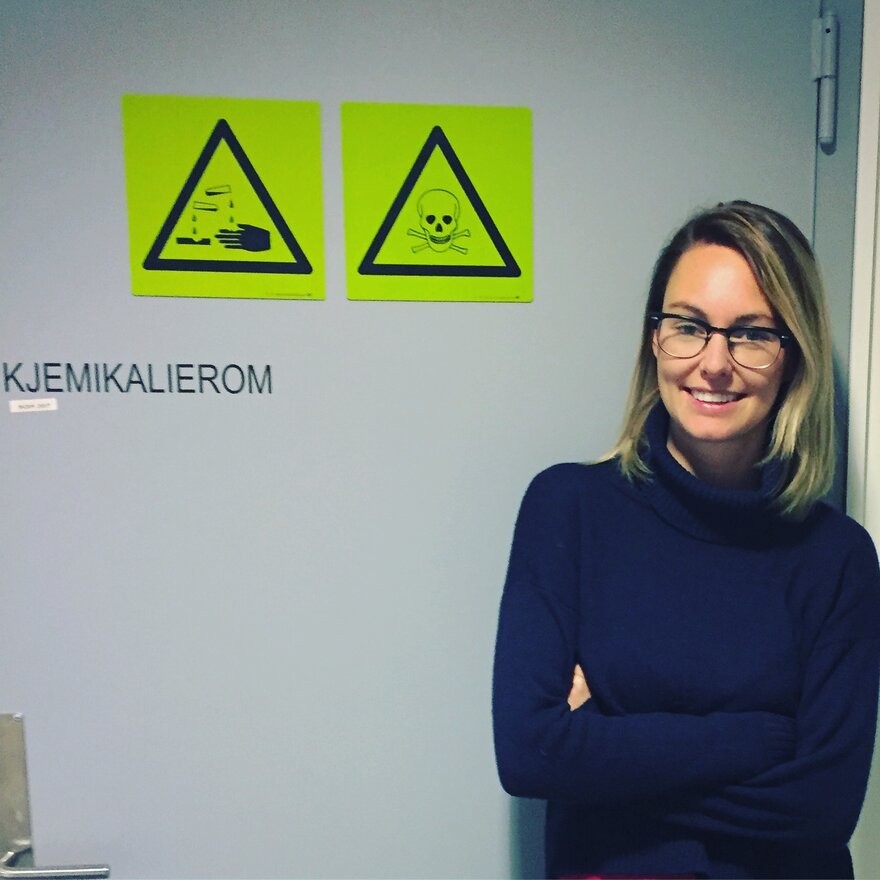
Tanya Helena Hevrøy
DSA
Results
We have published a literature review (Haanes et al. 2019) of microcosms suitable for use in radioecological studies. In radioecological studies size and location limitations are important as large volumes involve problems with waste and exposure to gamma fields. The review included recommendations for how microcosms can be optimized for studying the effect of ionizing radiation on ecosystems.
In addition, we have published a study on ionizing radiation effects in a small aquatic ecosystem (Hevrøy et al. 2019), where we exposed microcosms to gamma radiation in a climate chamber, and a mesocosm study that investigated the uptake of radionuclides in a benthic food web from the Baltic sea (Holmerin et al, submitted).
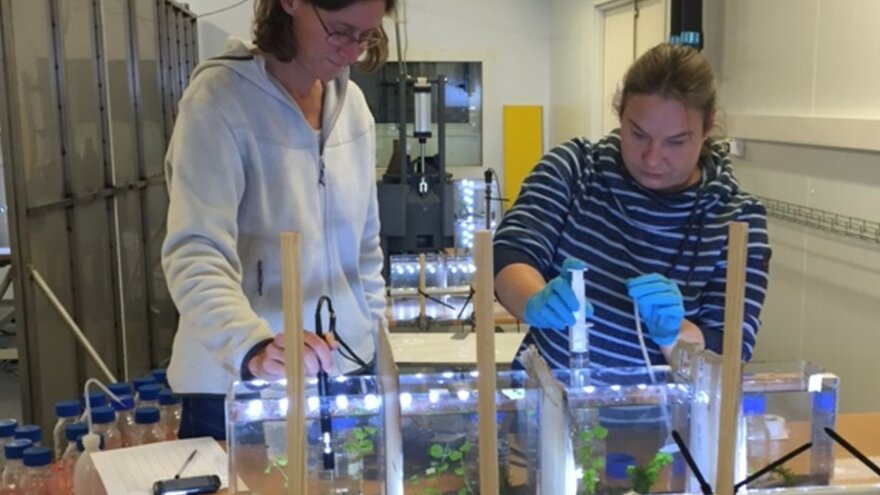
Sampling from microcosms exposed to gamma radiation in climate chamber at Figaro Facility at NMBU. Dr. Clare Bradshaw (left) and PhD student Anna-Lea Golz (right), both from Stockholm University. Photo: Tanya Hevrøy DSA Key publications
Holmerin, I., Jensen, L.K., Hevrøy, T.H. and Bradshaw, c. (submitted, 2020). Trophic Transfer of Radioactive Micronutrients in a Shallow Benthic Food Web. Environmental Toxicity and Chemistry
Haanes, H., Hansen, E.L., Hevrøy, T.H., Jensen, L.K., Gjelsvik, R., Jaworska, A. and Bradshaw, C. (2019). Realism and usefulness of multispecies experiment designs with regard to application in radioecology: A review. Science of the Total Environment, Vol.718.
Hevrøy, T. H., Golz, A-L., Hansen, E. L., Xie, L., Bradshaw, C. (2019). Radiation effects and ecological processes in a freshwater microcosm. Journal of Environmental Radioactivity 203: 71-83.
UMB4B: Potential Nuclear Events - assessing impact and risk from specific sources
Aim
The main aim of UMB4b is to evaluate and improve impact and risk assessment tools for establishing a scientifically based set of decision criteria. Impact and risk assessments rely on compiling relevant information of the source term and deposition, ecosystem transfer, biological uptake and effect.
All these help to determine if exposure scenarios encountered under normal conditions or emergency situations (incidents/accidents/malevolent acts) represent a risk to humans and wildlife. CERAD then performs sensitivity analysis to define which factors contribute the most to the overall uncertainties, thus setting the priorities for the research in RA1-RA3.
Leader
Methodology
UMB4b’s Western Norway case study explored the impacts a hypothetical nuclear accident in Sellafield in the UK would have for the west coast of Norway. This case study has been a cross-cutting activity that involved all CERAD partners and Research Areas. We have successfully coupled various models linking the source and release scenario to impacts on biota, man, and society).
Models have been adapted to Norwegian conditions to predict the total impact of radioactive releases affecting Norwegian territories. Key factors contributing to major uncertainties in each model have been identified and quantified and the need for model improvement defined. Several of the models have also been applied to assess potential impact in Norway from the sunken Russian submarines K-27 at Novaya Zemlya and K-59 north of Murmansk.

CERAD researchers have coupled 8 models that link source and release scenarios to effects, in order to increase our understanding of the factors that contribute most to the uncertainties Photo: UMB4b Key publications
Liland, A., Lind, O.C., Bartnicki, J., Brown, J.E., Dyve, J.E., Iosjpe, M., Klein, H., Lin, Y., Simonsen, M., Strand, P., Thørring, H., Ytre-Eide, M.A., and Salbu, B. (2020). Using a chain of models to predict health and environmental impacts in Norway from a hypothetical nuclear accident at the Sellafield site. Journal of Environmental Radioactivity 214–215, 106159.
Hosseini, A., I Amundsen, J Brown, M Dowdall, M Karcher, F Kauker et al. (2017). Impacts on the marine environment in the case of a hypothetical accident involving the recovery of the dumped Russian submarine K-27, based on dispersion of 137Cs. Journal of Environmental Radioactivity, 167, 170-179.
Bartnicki, J., Amundsen, I., Brown, J., Hosseini, A., Hov, O., Haakenstad, H., Klein, H., Lind, O.C., Salbu, B., Wendel, C.C.S., and Ytre-Eide, M.A. (2016). Atmospheric transport of radioactive debris to Norway in case of a hypothetical accident related to the recovery of the Russian submarine K-27. Journal of Environmental Radioactivity, 151, 404-416.
Brown, J., Amundsen, I., Bartnicki, J., Dowdall, M., Dyve, J., Hosseini, A., Klein, H., and Standring, W. (2016). Impacts on the terrestrial environment in case of a hypothetical accident involving the recovery of the dumped Russian submarine K-27. Journal of Environmental Radioactivity, 165, 1-12.
Brown, J., Hosseini, A., Karcher, M., Kauker, F., Dowdall, M., Schnur, R., and Strand, P. (2016). Derivation of risk indices and analysis of variablility for the management of incidents involving the transport of nuclear materials in the Northern Seas. Journal of Environmental Management, 171, 195-203.
UMB4C: Societal Impacts associated with socioeconomics, risk communication risk perception and stakeholder dialogue
Aim
UMB4C aims to evaluate the broader consequences of radiation events. This requires a multidisciplinary approach, as not only radiation contamination but also economic, societal, and ethical impacts pose challenges to society.
Economic and societal impacts are influenced by the way risks are perceived and communicated. Our research on communication of radiological risks highlighted a bias in media presentation of radiation risks.
Leader
Methodology
We used stakeholder dialogues, a particularly important approach in risk communication, and demonstrated how they can facilitate multidisciplinary assessment of risks. We held two stakeholder dialogue workshops in Rogaland where we gathered a number of important national, regional and local actors to discuss better post-accident management and recovery based on the Western Norway scenario. With these workshops have also showed that collaborative deliberation contributed to improved learning, networking, involvement and problem solving compared to pure information provision.
In addition to using stakeholder dialogues, CERAD also developed criteria for assessing the quality of stakeholder involvement processes. These criteria are: inclusiveness, independence, flexibility, continuity, influence, transparency and mutual learning.
CERAD co-organized the Miami consensus symposium where 30 scientists from different countries, disciplines and research areas developed seven consensus statements for better environmental radiation protection. We have also organized expert workshops for development of SHAMISEN recommendations for improved preparedness and follow-up of populations affected by nuclear accidents.
CERAD is part of the Task Group on the Ethical Foundations of Radiation Protection (under the International Commission on Radiological Protection (ICRP)). We organised a workshop on the ethical aspects of using apps and other tools to support data collection on radiation measurements, health and well-being indicators by citizens in preparedness for and recovery from a radiation accident, and assessed the ethical challenges associated with individual radiosensitivity. Ethical principles were also a key component of the Shamisen Recommendations mentioned above.

Recommendations to Improve Health of Populations in Case of a Nuclear Accident Photo: SHAMISEN Key publications
Kalman, C. and D.H. Oughton (2020). Ethical considerations related to radiosensitivity and radiosusceptibility. International Journal of Radiation Biology, Vol. 96 (3), 340-343.
Liland, A., Tomkiv, Y., Oughton, D.H., Navrud, S., Romstad, E. and Skuterud, L. (2019). The power of collaborative deliberation in stakeholder dialogue seminars. Journal of Risk Research, Vol. 22 (2), 243-267.
Tomkiv, Y., Liland, A., Oughton, D.H. and B. Wynne (2019). Assessing Quality of Stakeholder Engagement: From Bureaucracy to Democracy. Bulletin of Science, Technology & Society Vol. 37(3), 167–178.
Bréchignac, F., Oughton, D.H., Mays, C., Barnthouse, L., Beasley, J.C., Bonisoli-Alquati, A., Bradshaw, C., Brown, J., Dray, S., Geras’kin, S., Glenn, T., Highley, K., Ishida, K., Kapustka, L., Kautsky, U., Kuhne, W., Lynch, M., Mappes, T., (…) and Tsukada, H. (2016). Addressing ecological effects of radiation on populations and ecosystems to improve protection of the environment against radiation: Agreed statements from a Consensus Symposium. Journal of Environmental Radioactivity, Vol. 158-159, 21-29.
Tomkiv, Y., Perko, T., Oughton, D.H., Prezelj, I., Cantone, M.C. and Gallego, E. (2016). How did media present the radiation risks after the Fukushima accident: a content analysis of newspapers in Europe. Journal of Radiological Protection, Vol. 36 (2).